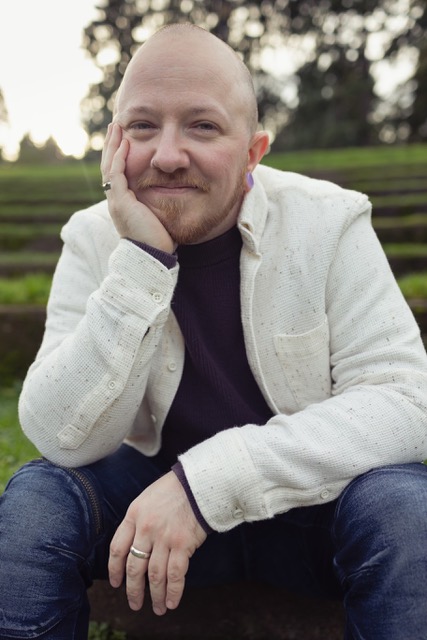If you or someone you know may be experiencing a mental health crisis, contact the 988 Suicide & Crisis Lifeline by dialing or texting “988.”
Elliott Hinkle experienced depression and suicidal thoughts even before entering the foster care system in Casper, Wyoming, at age 15.
At the time, Hinkle, who is transgender, struggled with their sexual identity and gender issues, and their difficulties continued in foster care. They felt like they had no one to confide in — not their foster parents, not church leaders, not their caseworker.
“To my knowledge, I don’t remember ever taking a suicide screening,” Hinkle said. “No one ever said: ‘Are you having thoughts of taking your life? Do you feel hopeless?’”
With their psychological and behavioral health needs left unaddressed, Hinkle’s depression and suicidal thoughts worsened.
“Do I stay in the closet and feel terrible and want to end my life?” Hinkle said. “Or do I come out and lose all my supports, which also feels dangerous?”
Children in foster care are significantly more likely to have mental health issues, researchers say. They attempt or complete suicide at rates three to four times that of youths in the general population, according to several studies.
LGBTQ+ people in foster care, like Hinkle, are at an even higher risk of having suicidal thoughts.

Yet despite the concentration of young people at risk of serious mental illness and suicide, proactive efforts to screen foster children and get them the treatment they need have been widely absent from the system. And now, efforts underway to provide widespread screening, diagnosis, and treatment are threatened by sweeping funding cuts the Trump administration is using to reshape health care programs nationwide.
In June, federal officials announced they would shut down a suicide hotline serving LGBTQ+ youths as part of those cuts.
Children in foster care use a disproportionate amount of Medicaid-funded mental health services. Meanwhile, President Donald Trump’s massive budget package, passed this month by Congress, contains substantial shifts in Medicaid funding and policies that are projected to drastically reduce services in many states.
“I think anybody who cares about kids’ well-being and mental health is concerned about the possibility of reduced Medicaid funding,” said Cynthia Ewell Foster, a child psychologist and clinical associate professor in the University of Michigan psychiatry department. “The most vulnerable children, including those in foster care, are already having trouble getting the services they need.”
A lack of federal standards and other system-level issues create barriers to psychological and behavioral care in the child welfare system, said Colleen Katz, a professor at Hunter College’s Silberman School of Social Work in New York.
“When you’re talking about anyone getting screened for suicide ideation upon entrance into the system, it’s inconsistent at best,” she said.
Katz said all children entering foster care should have a brief, standardized suicide screening embedded into their initial medical assessment. And more screenings need to be conducted throughout a foster care stay, she said, because youths getting ready to transition out of the system are also vulnerable.
Hinkle, now 31, said the summer before they aged out of the system was “one of the darkest periods, because I was coming to terms with the church not wanting me to be gay and I was about to lose stable housing and whatever foster care support there was.”
Katz studied transition-age youths in foster care in California, which has the highest numbers of placements in foster care nationwide. According to her analysis, 42% of study participants had thoughts of taking their life and 24% had attempted suicide, and she expects findings would be similar in other states.
Katz also examined suicide screening tools and found many that already exist could work and be easily administered by trained child welfare workers or alternative frontline service providers, or embedded in existing mental health services.
Still, the quality of services varies by state and locality and can hinder attempts to curb suicides.
Julie Collins, vice president of practice excellence at the Child Welfare League of America, which advocates for improvements to the child welfare system, said the gap in suicide prevention in foster care mirrors the overall nationwide void of behavioral health services for children and adolescents. “The preparation of people coming into the field isn’t what it needs to be,” Collins said of the lack of training for caseworkers.
Ewell Foster is trying to change that.
She worked with the state of Michigan to redefine and update the competencies required to earn an undergraduate certificate in child welfare in the state. Eighteen colleges and universities that offer certificate programs in child welfare in Michigan now teach about suicide prevention.
“It’s something the workforce has asked for,” Ewell Foster said. “They need real clear guidance on what to do when they are worried about someone.”
So far, Ewell Foster’s effort to change the wider system has not run into any roadblocks. Her work with Michigan’s child welfare agency is still being funded under a grant administered by the Substance Abuse and Mental Health Services Administration.
Agency spokesperson Danielle Bennett said such grants will continue for up to three years.
However, the future of the federal agency has been in question for months. The Trump administration has laid off hundreds of its employees and has proposed folding its functions into another agency.
Some states have made changes to address the foster care gaps on their own, but often it has taken legal action to spark changes in suicide prevention efforts.
In Kansas, officials made several changes after the state settled the McIntyre v. Howard class action lawsuit in 2021 on behalf of foster children who the suit alleged were subjected to inadequate access to mental health resources and moved from home to home frequently.
The state increased salaries for social workers in the child welfare system and reduced their caseloads, among other things.
Other states, including Texas, have implemented similar changes after facing lawsuits.
Still, experts caution that the changes taking place in foster care systems are not enough to steer outcomes.

Lily Brown, an assistant professor of psychology and director of the Center for the Treatment and Study of Anxiety at the University of Pennsylvania Perelman School of Medicine, said moving the needle in suicide prevention will require implementing a universal risk assessment for children in state care.
Brown recently sought a grant to fund and implement free, universal suicide risk screening in foster care throughout Pennsylvania. She had several counties agree to the project, but not enough to support her application — the study wouldn’t have had enough participants to work statistically, she said.
Without such studies, foster care systems nationwide can’t meet the needs of children, she said.
April Miller, 27, entered the system in Minnesota at age 3. As a Native American, she is part of a group that is overrepresented in foster care.
“The child welfare system as a whole neglected me,” said Miller, who said she endured several traumatic events in her early life, including witnessing a murder.
“I did a lot of self-harm and had thoughts of suicide but didn’t have access to means, which is why I am still alive,” she said.
Today, Miller is a social worker and suicide prevention coordinator in Bemidji, Minnesota.
Similarly, Hinkle’s experience in the system made them driven to change the trajectory of other young people.
Hinkle provides training, consultation, and policy development services at Unicorn Solutions in Oregon in support of youths and young adults affected by systems such as child welfare, with a particular focus on the LGBTQ+ community.
They said they are committed to making sure that sexual identity and gender topics are not avoided in the system.
“I think every young person should feel loved and cared for,” Hinkle said.
KFF Health News is a national newsroom that produces in-depth journalism about health issues and is one of the core operating programs at KFF—an independent source of health policy research, polling, and journalism. Learn more about KFF.
USE OUR CONTENT
This story can be republished for free (details).






